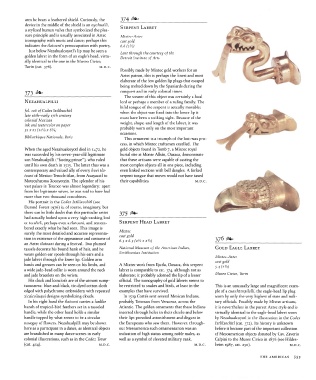Page 556 - Art In The Age Of Exploration (Great Section on Chinese Art Ming Dynasty)
P. 556
arm he bears a feathered shield. Curiously, the 374
device in the middle of the shield is an oyohualli, SERPENT LABRET
a stylized human vulva that symbolized the plea-
sure principle and is usually associated in Aztec Mixtec-Aztec
iconography with music and dance; perhaps this cast gold
indicates the tlatoani's preoccupation with poetry. 6.6 (2 / 2j
2
Just below Nezahualcoyotrs lip may be seen a Lent through the courtesy of the
golden labret in the form of an eagle's head, virtu- Detroit Institute of Arts
ally identical to the one in the Museo Civico,
Turin (cat. 376). M.D.C.
Possibly made by Mixtec gold workers for an
Aztec patron, this is perhaps the finest and most
elaborate of the few golden lip plugs that escaped
being melted down by the Spaniards during the
373 conquest and in early colonial times. a local
of this object was certainly
The wearer
NEZAHUALPILLI lord or perhaps a member of a ruling family. The
bifid tongue of the serpent is actually movable;
fol. 108 of Codex Ixtlilxochitl when the object was fixed into the lower lip it
late i6th-early lyth century
colonial Mexican must have been a striking sight. Because of the
ink and watercolor on paper weight, shape, and length of the labret, it was
l
l
31 X 21 (l2 /8 X 8 /4) probably worn only on the most important
occasions.
Bibliotheque Rationale, Paris This ornament is a triumph of the lost-wax pro-
cess, in which Mixtec craftsmen excelled. The
When the aged Nezahualcoyotl died in 1472, he gold objects found in Tomb 7, a Mixtec royal
was succeeded by his seven-year-old legitimate burial site at Monte Alban, Oaxaca, demonstrate
son Nezahualpilli ("fasting prince"), who ruled that these artisans were capable of casting the
until his own death in 1515. The latter thus was a most complex objects all in one piece, including
contemporary and valued ally of every huei tla- even linked sections with bell dangles. A forked
toani of Mexico-Tenochtitlan, from Axayacatl to serpent tongue that moves would not have taxed
Motecuhzoma Xocoyotzin. The splendor of his their capabilities. M.D.C.
vast palace in Texcoco was almost legendary; apart
from his legitimate wives, he was said to have had
more than two thousand concubines.
His portrait in the Codex Ixtlilxochitl (see
Durand-Forest 1976) is, of course, imaginary, but
there can be little doubt that this particular artist 375
had actually looked upon a very high-ranking lord
or tecuhtli, perhaps even a tlatoani, and remem- SERPENT HEAD LABRET
bered exactly what he had seen. This image is
surely the most detailed and accurate representa- Mixtec
cast gold
tion in existence of the appearance and costume of 6.5X6.5 (21/2X21/2) 376
an Aztec tlatoani during a festival. Two plumed
tassels decorate his bound hank of hair, and he National Museum of the American Indian, GOLD EAGLE LABRET
wears golden ear spools through his ears and a Smithsonian Institution
jade labret through the lower lip. Golden arm Mixtec-Aztec
cast gold
(
bands and greaves can be seen on his limbs, and A Mixtec work from Ejutla, Oaxaca, this serpent 5.4 y )
a wide jade-bead collar is worn around the neck labret is comparable to cat. 374, although not as 2 8
and jade bracelets on the wrists. elaborate; it probably adorned the lip of a lesser Museo Civico, Turin
His cloak and loincloth are of the utmost sump- official. The iconography of gold labrets seems to
tuousness: blue-and-black, tie-dyed cotton cloth be restricted to snakes and birds, at least in the This is an unusually large and magnificent exam-
edged with polychrome embroidery with repeated examples that have survived. ple of a cuauhtenpilolli, the eagle-head lip plug
xicalcoliuqui designs symbolizing clouds. In 1519 Cortes sent several Mexican Indians, worn by only the very highest of state and mili-
In his right hand the tlatoani carries a fanlike probably Totonacs from Veracruz, across the tary officials. Possibly made by Mixtec artisans,
bunch of tropical-bird feathers set in a tasseled Atlantic. The golden ornaments that these Indians it is nevertheless in the purest Aztec style and is
handle, while the other hand holds a similar inserted through holes in their cheeks and below virtually identical to the eagle-head labret worn
handle topped by what seems to be a circular their lips provoked astonishment and disgust in by Nezahualcoyotl in the illustration in the Codex
nosegay of flowers. Nezahualpilli may be shown the Europeans who saw them. However, through- Ixtlilxochitl (cat. 372). Its history is unknown
here as a participant in a dance, as identical objects out Mesoamerica such ornamentation was an before it became part of the important collection
are brandished in many dance scenes in early indication of high status among noble males, as of Mesoamerican objects donated by Cav. Zaverio
colonial illustrations, such as in the Codex Tovar well as a symbol of elevated military rank. Calpini to the Museo Civico in 1876 (see Hildes-
(cat. 404). M.D.C. M.D.C. heim 1987, cat. 250). M.D.C.
THE AMERICAS 555

